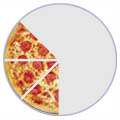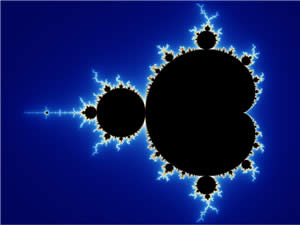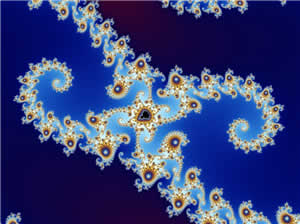Open House
Tomorrow 8/17/19 @ 6.p.m.
Pascal's Triangle
One of the most interesting Number Patterns is Pascal's Triangle (named after Blaise Pascal, a famous French Mathematician and Philosopher).
To build the triangle, start with "1" at the top, then continue placing numbers below it in a triangular pattern.
Each number is the numbers directly above it added together.
Each number is the numbers directly above it added together.
(Here I have highlighted that 1+3 = 4)
Patterns Within the Triangle

Diagonals
The first diagonal is, of course, just "1"s
The next diagonal has the Counting Numbers(1,2,3, etc).
The third diagonal has the triangular numbers
(The fourth diagonal, not highlighted, has the tetrahedral numbers.)
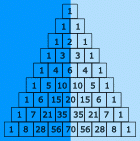
Symmetrical
The triangle is also symmetrical. The numbers on the left side have identical matching numbers on the right side, like a mirror image.
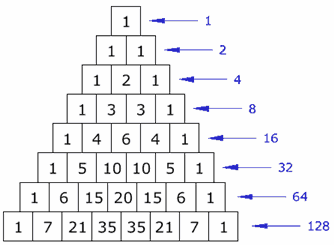
Horizontal Sums
What do you notice about the horizontal sums?
Is there a pattern?
They double each time (powers of 2).
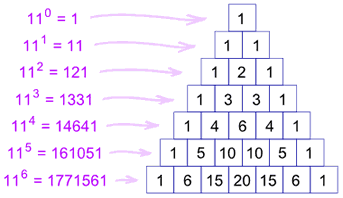
Exponents of 11
Each line is also the powers (exponents) of 11:
- 110=1 (the first line is just a "1")
- 111=11 (the second line is "1" and "1")
- 112=121 (the third line is "1", "2", "1")
- etc!
But what happens with 115 ? Simple! The digits just overlap, like this:

The same thing happens with 116 etc.
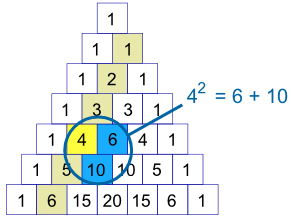
Squares
For the second diagonal, the square of a number is equal to the sum of the numbers next to it and below both of those.
There is a good reason, too ... can you think of it? (Hint: 42=6+10, 6=3+2+1, and 10=4+3+2+1)
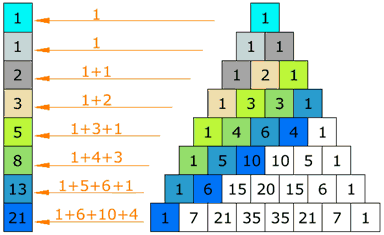
Fibonacci Sequence
Try this: make a pattern by going up and then along, then add up the values (as illustrated) ... you will get the Fibonacci Sequence.
(The Fibonacci Sequence starts "0, 1" and then continues by adding the two previous numbers, for example 3+5=8, then 5+8=13, etc)
(The Fibonacci Sequence starts "0, 1" and then continues by adding the two previous numbers, for example 3+5=8, then 5+8=13, etc)
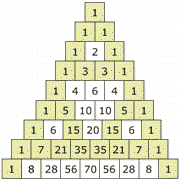
Odds and Evens
If you color the Odd and Even numbers, you end up with a pattern the same as the Sierpinski Triangle
Using Pascal's Triangle
Heads and Tails
Pascal's Triangle can show you how many ways heads and tails can combine. This can then show you the probability of any combination.
For example, if you toss a coin three times, there is only one combination that will give you three heads (HHH), but there are three that will give two heads and one tail (HHT, HTH, THH), also three that give one head and two tails (HTT, THT, TTH) and one for all Tails (TTT). This is the pattern "1,3,3,1" in Pascal's Triangle.
| Tosses | Possible Results (Grouped) | Pascal's Triangle |
|---|---|---|
| 1 | H T | 1, 1 |
| 2 | HH HT TH TT | 1, 2, 1 |
| 3 | HHH HHT, HTH, THH HTT, THT, TTH TTT | 1, 3, 3, 1 |
| 4 | HHHH HHHT, HHTH, HTHH, THHH HHTT, HTHT, HTTH, THHT, THTH, TTHH HTTT, THTT, TTHT, TTTH TTTT | 1, 4, 6, 4, 1 |
| ... etc ... |
Combinations
The triangle also shows you how many Combinations of objects are possible.
A Formula for Any Entry in The Triangle
In fact there is a formula from Combinations for working out the value at any place in Pascal's triangle:
| It is commonly called "n choose k" and written like this: |  |
Notation: "n choose k" can also be written C(n,k), nCk or even nCk.
 | The "!" is "factorial" and means to multiply a series of descending natural numbers. Examples:
|
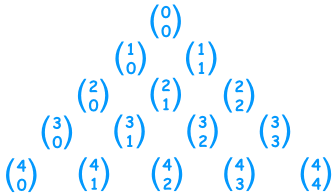
So Pascal's Triangle could also be
an "n choose k" triangle like this one.
an "n choose k" triangle like this one.
(Note how the top row is row zero
and also the leftmost column is zero)
and also the leftmost column is zero)
This can be very useful ... you can now work out any value in Pascal's Triangle directly (without calculating the whole triangle above it).
Polynomials
Pascal's Triangle can also show you the coefficients in binomial expansion:
| Power | Binomial Expansion | Pascal's Triangle |
|---|---|---|
| 2 | (x + 1)2 = 1x2 + 2x + 1 | 1, 2, 1 |
| 3 | (x + 1)3 = 1x3 + 3x2 + 3x + 1 | 1, 3, 3, 1 |
| 4 | (x + 1)4 = 1x4 + 4x3 + 6x2 + 4x + 1 | 1, 4, 6, 4, 1 |
| ... etc ... |
The First 15 Lines
For reference, I have included row 0 to 14 of Pascal's Triangle
1
1
1
1
2
1
1
3
3
1
1
4
6
4
1
1
5
10
10
5
1
1
6
15
20
15
6
1
1
7
21
35
35
21
7
1
1
8
28
56
70
56
28
8
1
1
9
36
84
126
126
84
36
9
1
1
10
45
120
210
252
210
120
45
10
1
1
11
55
165
330
462
462
330
165
55
11
1
1
12
66
220
495
792
924
792
495
220
66
12
1
1
13
78
286
715
1287
1716
1716
1287
715
286
78
13
1
1
14
91
364
1001
2002
3003
3432
3003
2002
1001
364
91
14
1











